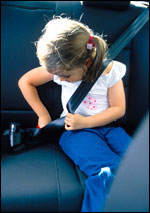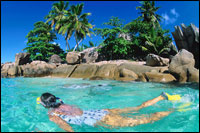Safe Travel
 Has Punxsutawney Phil's extended winter prediction made you want to escape your local forecast with an international trip? Whatever your reason for traveling this winter, here are a few simple tips for a safe and healthy trip!
Has Punxsutawney Phil's extended winter prediction made you want to escape your local forecast with an international trip? Whatever your reason for traveling this winter, here are a few simple tips for a safe and healthy trip!
Whether you plan to escape the winter cold and travel to the tropics or hit the slopes at a snowy resort, don't forget to plan for your health! While every destination is different, these tips can help you plan for a safe and healthy trip. Visit Your Survival Guide to Safe and Healthy Travel to learn even more about planning for your trip.
In Transit to Your Destination
Sitting in one place for a long time, such as sitting on a long plane flight, can cause Deep Vein Thrombosis or DVT. DVT is a blood clot that forms in a deep vein and can partially or completely block blood flow. You can prevent DVT during long flights in the following ways:
- Drink plenty of water to stay hydrated.
- Wear loose-fitting clothing.
- Walk and stretch your legs and arms regularly during your flight.
- Wear compression stockings or support hose.
Jet lag happens when a traveler crosses several time zones rapidly. Although jet lag is not fully understood, you can ease the negative effects of jet lag by following these four tips:
- Avoid large meals.
- Drink plenty of water to stay hydrated.
- Avoid caffeine and alcohol while in flight.
- Get plenty of sunlight once you arrive at your destination to help you adjust to the time difference.
For All Destinations
You might be surprised to learn that motor vehicle injuries are the leading cause of preventable death among international travelers.  Injuries involving car, bus, and motorcycle crashes, as well as pedestrian injuries, are more common during travel than you might think. Follow these tips to help prevent injuries in cars and other vehicles:
Injuries involving car, bus, and motorcycle crashes, as well as pedestrian injuries, are more common during travel than you might think. Follow these tips to help prevent injuries in cars and other vehicles:
- Wear a seat belt.
- Make sure that children always ride in safety seats. Bring your child's safety seat from home.
- Ride only in marked taxis.
- Be alert when crossing the street, especially in countries where automobiles travel on the opposite side of the road.
- Avoid travel on overloaded buses or vans.
- When possible, hire a local driver instead of driving yourself. Ask your hotel for a trustworthy driver or taxi company.
- Avoid local air travel at night, and during inclement weather.
- Don't drink and drive.
Overexposure to harmful UV rays can lead to another health problem found in all destinations: sunburn. Countries that are near the equator and areas of higher elevation receive more UV rays, making short exposures to the sun more dangerous. Outdoor activities, such as skiing and swimming, increase sun exposure. Prevent sunburn by following these tips:
- Use a sunscreen with SPF 15 or higher.
- Be sure to reapply sunscreen often, especially after swimming.
- Wear a wide-brimmed hat and sunglasses with almost 100% UV protection.
- Wear long-sleeved shirts and long pants that have a tight weave.
- Seek shade while outside, especially between 10 a.m. and 4 p.m. when UV rays are strongest.
Cold Weather Destinations
 For travel to cold weather climates, make sure that you pack clothes and gear that will protect you against cold temperatures. Spending long amounts of time in very cold weather can be dangerous and can result in hypothermia or frostbite. Protect yourself from the cold by following these tips:
For travel to cold weather climates, make sure that you pack clothes and gear that will protect you against cold temperatures. Spending long amounts of time in very cold weather can be dangerous and can result in hypothermia or frostbite. Protect yourself from the cold by following these tips:
- Dress warmly and in layers.
- Wear inner clothing layers made from wool, silk, or polypropylene, as they retain more body heat than cotton.
- Wear insulated and waterproof shoes to prevent cold, wet feet.
- Don't forget a hat, scarf, and mittens or gloves.
Warm Weather Destinations
If you are traveling to warm weather climates, don't forget to protect yourself against heat-related illnesses, such as heat exhaustion and heatstroke. Stay cool with these tips:
- Drink plenty of water to stay hydrated.
- Make sure to drink even more fluids during exercise.
- Limit outdoor activities to morning and evening hours.
- Wear a hat and use sunscreen, even on cloudy days.
 Swimming and other water sports, such as scuba diving, are common activities for warm weather travelers. Don't forget to be safe when doing activities in and around water.
Swimming and other water sports, such as scuba diving, are common activities for warm weather travelers. Don't forget to be safe when doing activities in and around water.
- Avoid alcohol and drug use before and during water activities.
- Supervise children at all times.
- Select areas that have good water quality and safe conditions.
- Be careful around marine plants and animals, especially coral.
- Be sure to use sunscreen with at least SPF 15, especially on vulnerable areas such as your face and back.
All International Destinations
Before any international trip, make sure to visit CDC's Travelers' Health Web site to learn more about the health risks at your destination(s) and what you can do to ensure a healthy trip.
Current Features
Need info on a
different topic? See


